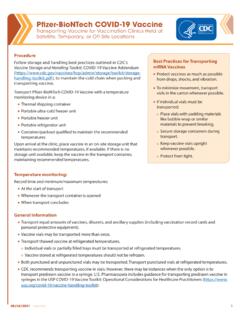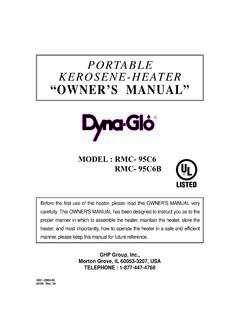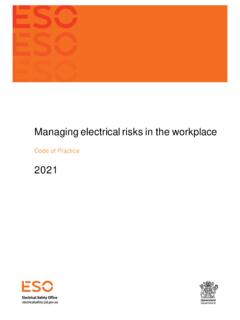Transcription of Occupational health and safety (OHS) working alone ...
1 Occupational health and safety (OHS) working alone requirements OHS information for workers and employers 2019 Government of Alberta WA002 - February - 2019 KEY INFORMATION A worker is considered to be working alone if they work alone at a work site where assistance is not readily available. The purpose of this publication is to explain the requirements of Part 28 of the OHS Code. If two or more workers of the same employer or different employer are working together, the working alone requirements of the OHS Code do not apply. Workers who work alone Workers who work alone can be grouped into five broad categories: 1. Workers who handle cash. Examples can include convenience store clerks, retail and food outlet workers, and taxi drivers. 2. Workers who travel away from base offices to meet clients.
2 Examples can include home care workers, social services workers and bylaw enforcement officers. 3. Workers who do hazardous work but have no routine interaction with customers or the public. Examples can include workers in logging, and oil and gas industries. 4. Workers who travel alone but have no routine interaction with customers or the public. Examples can include truck drivers and business people in transit. 5. Workers who are at risk of a violent attack because their work site is isolated from public view. Examples can include security guards and custodians. Employer requirements for workers who work alone If an employer has workers who work alone , the OHS Code requires the employer to: Conduct a hazard assessment to identify existing or potential health and safety hazards in the workplace associated with working alone .
3 Implement health and safety measures to eliminate, or if elimination is not reasonably practicable, control the risk to workers from the identified hazards. Ensure that workers have an effective way of communicating with their employer, immediate supervisor or another designated person in case of an emergency situation. Contact the workers at regular intervals appropriate to the hazards associated with the work. Ensure that workers are trained and educated so they can perform their job safely. Special provisions for retail fuel and convenience store workers If a worker at a gas station, retail fuelling outlet or convenience store is working alone the employer must provide a personal emergency transmitter monitored by the employer or the employer s designate.
4 The personal emergency transmitter must be on the worker at all times while working alone (Workplace Violence Prevention Plan BP031). When is a worker working alone ? The working alone requirements of the OHS Code apply when both of the following conditions are met: working alone requirements OHS expl Employers can eliminate the risk of workers working alone if they: choose to organize work schedules and procedures to eliminate the need for workers to work by themselves overlap shifts, having multiple workers work together rearrange the physical location of the work so that workers maintain contact with one another a worker is working by themselves assistance, in the event of an injury, illness or emergency, is not readily available to the worker Determining if assistance is readily available Three factors determine if assistance is readily available in the event of an injury, illness or emergency.
5 1. Awareness will other persons capable of providing assistance be aware of the worker s needs? 2. Willingness is it reasonable to expect those other persons will provide helpful assistance? 3. Timelines will assistance be provided within a reasonable period of time? This assessment must consider the level of risk associated with the circumstances of the work, type of work, location, hazards, etc. If the worker faces hazards that pose a high risk of injury, readily available may mean immediately available . What do employers need to do? When a worker is required to work alone , the employer shall: Conduct a hazard assessment to identify existing or potential hazards arising from the conditions and circumstances of the worker s work (see For more information section).
6 Implement appropriate measures to eliminate or control the hazards identified. Establish an effective means of communication between the worker and persons capable of responding to the worker s need. Contact the worker at regular intervals appropriate to the hazards associated with the work. Ensure a means of communication Effective means of communication means provision of radio, telephone or another electronic communication device by the employer, plus regular contact with the worker by the employer (or their designate) at intervals appropriate to the nature of hazards associated with the workers work. Alternate means of communication If an effective means of communication is not practicable or readily available at the work site the employer (or their designate) shall: visit the worker; or ensure the worker contacts the employer (or their designate) at time intervals appropriate to the nature of the hazards associated with the worker s work Video surveillance camera Maintaining contact with workers can be achieved through use of video surveillance cameras.
7 The employer s hazard assessment should assess to what extent workers using this system can respond to other workers who require assistance. A remote video monitoring room or a non-continuous surveillance system that regularly switches images between several monitoring cameras may or may not meet the readily available assistance criterion of the OHS Code. The hazard assessment should help to determine if this is the case. working alone requirements OHS expl Examples The following examples describe typical workplace situations in general terms: Example 1: A worker is the only staff member on duty at a food court restaurant where other workers are present at nearby food outlets. Although a worker present at other food outlets could reasonably be expected to provide or get assistance, the working alone requirements of the OHS Code would not apply in this situation since both conditions described are not met.
8 However, a lone worker at a stand- alone food outlet would meet working alone conditions because the worker, if injured due to an incident or as a result of a confrontation customer, would have no way of getting assistance. Example 2: A worker equipped with a portable two-way radio or cellular telephone is working by themselves in an area where the worker cannot be seen or heard by persons capable of offering assistance. The two conditions applicable to working alone apply in this example. The worker is working by themselves and assistance is not readily available because the worker cannot be seen or heard by persons capable of offering assistance. While part of the solution, the fact that the worker has a portable two-way radio or a cellular telephone is not a relevant factor when assessing against the two conditions.
9 Because the two working alone conditions are met, the employer is required to conduct a hazard assessment to identify existing or potential hazards arising from the conditions and circumstances of the worker s work. The employer must also establish an effective means of communication between the worker and persons capable of responding to the worker s needs. The assessment may show that the portable two-way radio or cellular telephone is effective, or may suggest alternatives are necessary. Example 3: A worker driving on the highway between Calgary and Edmonton versus a worker driving on a remote logging road. It is reasonable to expect during daytime hours a worker driving the highway requires assistance, other highway users would become aware of the need, and do so in a timely manner.
10 The working alone requirements do not apply; however, if driving at night, particularly on a less traveled roadway, working alone requirements could apply. By contrast, it is reasonable to expect that a worker driving on a remote logging road will not encounter anyone on the roadway. In the event of an injury, illness or emergency, it is unreasonable to expect someone will be aware of the situation or be willing to provide assistance in a timely manner. The working alone requirements apply. Example 4: A nurse on night shift at a psychiatric unit versus a nurse on dayshift at a children s unit. The circumstances of the work in these two situations are quite different, although the work site the health care centre is the same. The availability of assistance in each situation must be assessed individually from the perspective of awareness, willingness and timeliness.

















